Mariposite
An informal name used for green micas and a variety of rocks that contain them.
Article by: Hobart M. King, PhD
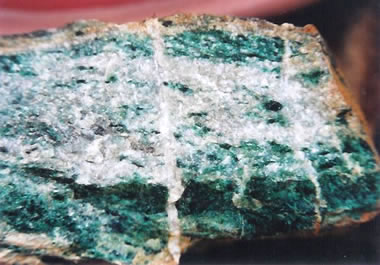
Mariposite: This is a rock that many people would call "mariposite" because it contains an abundance of green mica minerals. Photo by Robert Holland, displayed here under a Creative Commons license.
What Is Mariposite?
"Mariposite" is an informal name that is most often used for green micas that are thought to be colored by small amounts of chromium. The name "mariposite" has also been used for a group of green and white metamorphic rocks that contain significant amounts of green mica. "Mariposite" has been used in many different contexts since the late 1800s.
The name originates from the community of Mariposa, California. Green mica and green rocks that derive their color from green mica are seen in a few spectacular outcrops in that area. During the California Gold Rush, many prospectors learned that mariposite rocks were often sources of gold. Looking for green and white rocks became a prospecting method that sometimes resulted in success.
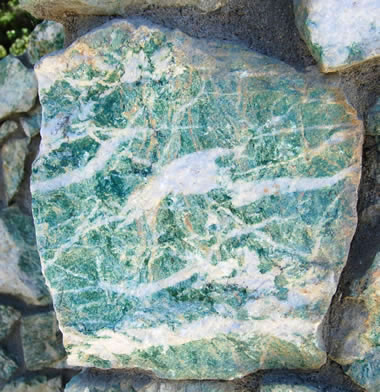
Mariposite: A photograph of "mariposite" showing its typical appearance as a complex rock, composed of numerous minerals, and often highly fractured, with veins of quartz or calcite of various sizes. This piece of "mariposite" is one of many stones used to build the monument shown on this page. Click for larger image. Photo by Yath, displayed here under a Creative Commons license.
Is Mariposite a Mineral?
The name "mariposite" has appeared in the geological literature since the late 1800s. "Mariposite" is not the name of a formally recognized mineral. Instead, it is an informal name that has been widely used for various types of mica with a green color. Green micas are often called "mariposite," which implies that an identification has been made. It would probably be better to simply call the material "green mica."
Making a positive identification, to the species level, of tiny grains of mica in the field can be difficult to impossible. It was problematic in a well-equipped lab in the late 1800s and early 1900s. Even today, positive identification can require chemical, mineralogical, or microscopic testing by an experienced mineralogist.
Examples of how the name "mariposite" has been used between 1897 and 2010 in publications of the United States Geological Survey are given below:
 "mariposite (a green mica containing a small amount of chromium)" [2] "mariposite (a green mica containing a small amount of chromium)" [2] "a chromium mica which is probably mariposite" [3] "a chromium mica which is probably mariposite" [3] "the chromiferous potassium mica mariposite" [4] "the chromiferous potassium mica mariposite" [4] "chlorite and a yellowish sericite are erroneously identified as mariposite" [4] "chlorite and a yellowish sericite are erroneously identified as mariposite" [4] "mariposite -- a green chromiferous sericite" [4] "mariposite -- a green chromiferous sericite" [4] "Mariposite can be identified only by means of chemical and microscopical tests, ordinary visual identification is worthless." [4] "Mariposite can be identified only by means of chemical and microscopical tests, ordinary visual identification is worthless." [4] "Mariposite, the chromian phengite" [5] "Mariposite, the chromian phengite" [5] "fuchsite/mariposite" [6] "fuchsite/mariposite" [6] "chromium mica (?mariposite? in older literature)" [7] "chromium mica (?mariposite? in older literature)" [7] "[the] distinctive green mica, which has been referred to by the varietal names mariposite and fuchsite is most appropriately classified as chromian phengite" [8] "[the] distinctive green mica, which has been referred to by the varietal names mariposite and fuchsite is most appropriately classified as chromian phengite" [8]
|
Clearly, the name "mariposite" has been used many ways. This lack of consistent use probably contributes to "mariposite" being called a "discredited name" in the Glossary of Geology, Fifth Edition, published by the American Geosciences Institute. [9]
If you continue reading, you will find that things discredited will sometimes have value.
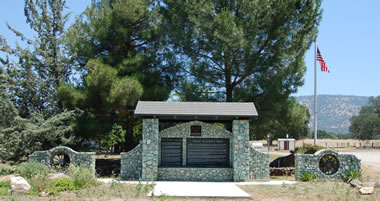
Mariposite Monument: This beautiful monument, located in Mariposa County and made with mariposite, gives information about the town of Cathey's Valley, CA. Photo by Yath, displayed here under a Creative Commons license. Click for larger image.
The Metamorphic Rock Called "Mariposite"
The name "mariposite" is also used for rocks. The rocks contain enough particles of green mica to produce a green color. These rocks are metamorphic, have been altered by hydrothermal activity, and they are usually thought to have a serpentinite protolith. The green mica usually accounts for a small percentage of the rock, with the major constituents being quartz, calcite, dolomite, ankerite or barite.
During the California Gold Rush, prospectors learned that "mariposite" was sometimes a host rock of gold. The sight of mariposite as stream cobbles or in outcrops became a well-known sign that gold might be present. This knowledge was later used in the search for gold in other parts of California, British Columbia, Alaska, and other parts of the world.
Mariposite Mineral Localities
Use of the name "mariposite" for green micas has also spread across the world. Mindat.org lists numerous mariposite localities in the United States (Alaska, Arizona, California, Colorado, Nevada, Tennessee, Utah, Washington), Austria, Canada, China, France, Ireland, Japan, Papua New Guinea, Spain, Sweden, and Venezuela. [1]
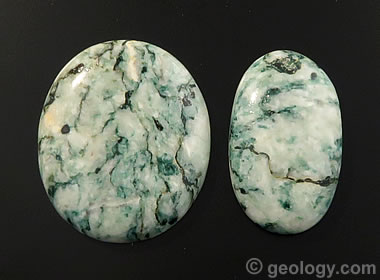
Mariposite Cabochons: These cabochons were made from material mined in California.
Uses of Mariposite
Mariposite is most important for being an ore of gold and a source of placer gold. It has been cut as a dimension stone to produce cemetery markers, fireplaces, facing stone and other architectural works. It is a material that can be used where strength and weather resistance are not required. Much mariposite will weather to a muddy brown color that can disappoint people who use it for an exterior project.
Mariposite is sometimes used to produce crushed stone. This beautiful material is used as landscape stone in some parts of California by people who are lucky enough to obtain it. Some people who know about mariposite's association with the California Mother Lode will be tempted to pick up a few pieces to look for the yellow metal. More often they will find pyrite.
Mariposite has many lapidary uses. It is used to make attractive cabochons, spheres, paperweights, bookends, and tumbled stones. Anyone who uses mariposite in lapidary projects must be mindful that the rock is composed of several minerals which may have incompetent boundaries, different hardnesses, and polish to different degrees of luster. The best specimens for lapidary use are solid pieces made up mostly of quartz, without any signs of weathering.
| Mariposite Information |
|
[1] Mariposite, an article on the mindat.org website, accessed March 2018.
[2] Description of the Gold Belt, by F. Becker, H.W. Turner and Waldemar Lindgren; Geologic Atlas of the United States, Sonora Folio, Volume 41; U.S. Geological Survey; 1897; 5 pages. [3] Notes on the Vanadium Deposits Near Placerville, Colorado, by Frank L. Hess; in Contributions to Economic Geology, Part I, Metals and Nonmetals Except Fuels -- Rare Metals; Bulletin 530-C; United States Geological Survey, 1911, pages 142-178. [4] The Mother Lode System of California, by Adolph Knopf, Professional Paper 157; United States Geological Survey; 1929, 88 pages. [5] Genesis of Gold-Bearing Quartz Veins of the Alleghany District, California, by A. S. Radtke, R. W. Wittkopp and Chris Heropoulos; in Proceedings of the Symposium on Mineral Deposits of the Pacific Northwest; Open-File Report 81-355; United States Geological Survey; 1980; pages 278-293. [6] Geoenvironmental Model for Low-Sulfide Gold-Quartz Vein Deposits, by Roger P. Ashley; Chapter K in Progress on Geoenvironmental Models for Selected Mineral Deposit Types, by Robert R. Seal II and Nora K. Foley, Editors; Open-File Report 02-195; United States Geological Survey, 2002, 213 pages. [7] Sixteen-to-One Mine; Deposit ID 10310678; entry in the Mineral Resources Data System; United States Geological Survey; 2005. [8] Geology and Metal Zoning of the Greens Creek Massive Sulfide Deposit, Southeastern Alaska by Cliff D. Taylor, Andrew W. West, Kerry G. Lear, Tim E. Hall, and John M. Proffett; Chapter 6 of Geology, Geochemistry, and Genesis of the Greens Creek Massive Sulfide Deposit, Admiralty Island, Southeastern Alaska, edited by Cliff D. Taylor and Craig A. Johnson; Professional Paper 1763, United States Geological Survey; pages 123-136, 2010. [9] Glossary of Geology, Fifth revised edition, edited by Klaus K.E. Neuendorf, James P. Mehl, Jr., and Julia A. Jackson; American Geosciences Institute, 2011, 800 pages. [10] Mariposite: The Rock That Made California Famous, by George W. Peabody; California Geology; California Department of Conservation, Division of Mines and Geology; pages 183-185; August 1991. |
| More Rocks |
 |
Tumbled Stones |
 |
Fossils |
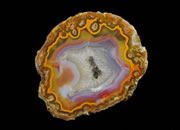 |
Geodes |
 |
The Rock Used to Make Beer |
 |
Topo Maps |
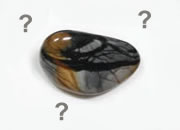 |
Difficult Rocks |
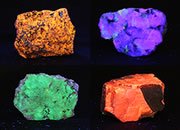 |
Fluorescent Minerals |
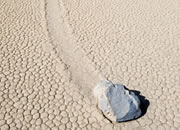 |
Sliding Rocks on Racetrack Playa |

Find Other Topics on Geology.com:

|

| ||

|

| ||

|

| ||

|

|
